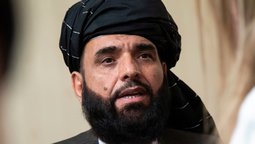Operation Heraclius: Difference between revisions
(Created page with "{{Infobox military conflict | conflict = Operation Heraclius | width = 400px | partof = Global War on Terrorism | image = Mollah Abdul Lateef el-Sabet...") |
|||
| Line 52: | Line 52: | ||
==Background== | ==Background== | ||
In the aftermath of the hostage crisis at the Burj Rafal hotel in Saudi Arabia, the main perpetrator Taalib el-Saladin was identified as one of the leading operators in the establishment of a Taliban terrorist cell in Saudi Arabia. Through extensive efforts, the British government was able to identify Mollah Abdul Lateef el-Sabet, a 51-year old Afghan-Saudi national. Reportedly, during the Soviet intervention in Afghanistan, El-Sabet was among the | In the aftermath of the hostage crisis at the Burj Rafal hotel in Saudi Arabia, the main perpetrator Taalib el-Saladin was identified as one of the leading operators in the establishment of a Taliban terrorist cell in Saudi Arabia. Through extensive efforts, the British government was able to identify Mollah Abdul Lateef el-Sabet, a 51-year old Afghan-Saudi national. Reportedly, during the Soviet intervention in Afghanistan, El-Sabet was among the number of men from Saudi Arabia that went to Afghanistan to assist the local Mujahadeen in driving out Soviet forces from Afghanistan with the aid of the CIA. | ||
==Burj Rafal Hostage Crisis== | ==Burj Rafal Hostage Crisis== | ||
Revision as of 15:04, 24 April 2020
| Operation Heraclius | |||||||
|---|---|---|---|---|---|---|---|
| Part of Global War on Terrorism | |||||||
 Mollah Abdul Lateef el-Sabet, Taliban lieutenant and orchestrator of the Burj Rafal Hostage Crisis | |||||||
| |||||||
| Belligerents | |||||||
|
Saudi Arabia |
| ||||||
| Commanders and leaders | |||||||
|
|
Abdul Lateef el-Sabet † Abdel Tariq | ||||||
| Strength | |||||||
| 35 UKSF and 26 MI6 operators | Unspecified | ||||||
| Casualties and losses | |||||||
| 3 killed, 7 wounded | 45 killed, 22 captured | ||||||
Operation Heraclius was a military operation initiated by the United Kingdom Special Forces to hunt down Taliban lieutenant, Mollah Abdul Lateef el-Sabet and eliminate the Taliban's terrorist cell in Saudi Arabia. It was initiated in response to the Burj Rafal Hostage Crisis.
Background
In the aftermath of the hostage crisis at the Burj Rafal hotel in Saudi Arabia, the main perpetrator Taalib el-Saladin was identified as one of the leading operators in the establishment of a Taliban terrorist cell in Saudi Arabia. Through extensive efforts, the British government was able to identify Mollah Abdul Lateef el-Sabet, a 51-year old Afghan-Saudi national. Reportedly, during the Soviet intervention in Afghanistan, El-Sabet was among the number of men from Saudi Arabia that went to Afghanistan to assist the local Mujahadeen in driving out Soviet forces from Afghanistan with the aid of the CIA.
Burj Rafal Hostage Crisis
In 2017, one of El-Sabet's lieutenants, Taalib El-Saladin was ordered to reportedly assassinate the British monarch, Alexandra I in retaliation towards her involvement in Afghanistan as part of the UKSF. Despite initial success, the plan failed and El-Saladin was killed alongside a few of his comrades while the remaining fighters were interrogated and later executed.
On the 20th of August 2017, the Saudi and British governments reached an agreement on a joint operation to hunt down Taliban fighters and associates in Saudi Arabia.
Operation
November Raid
On the 4th of November, in what would be one of the earliest success in the operation, a group of 20 Saudi police officers staged a raid and successfully apprehended 16 Afghan nationals in a private compound in the eastern city of Haradh. Three days later, government news agencies deduced that a further number of 17 Taliban "associates" had been caught in a closed location.
Dawn Raid
| Raid on Abdel Tariq's compound | |||||||
|---|---|---|---|---|---|---|---|
| Part of Operation Heraclius | |||||||
 Residential compound of Abdel Tariq in Jubail, Saudi Arabia | |||||||
| |||||||
| Belligerents | |||||||
|
|
| ||||||
| Commanders and leaders | |||||||
|
Abdel Tariq | |||||||
| Strength | |||||||
| 10 UKSF operators | 5 armed fighters, 25 civillian | ||||||
| Casualties and losses | |||||||
| 4 wounded | 7 killed, 11 wounded, 12 captured | ||||||
In following up on the success of the November Raid, British SOF operators under Major General James Chiswell were deployed to Saudi Arabia alongside several MI6 operators. Reportedly, just three days after their arrival, British intelligence were informed of the whereabouts of Abdel Tariq, a minor Taliban commander who was said to had been initially scheduled to lead the insurgency at the Burj Rafal hotel, before the former was replaced in favour of another candidate.
The planning phase for the raid quickly began on the 19th of November. During the process, British intelligence expertly surveyed and deduced Abdel Tariq's mannerism, his daily schedule and operations. Alongside this was vital information that Abdel Tariq would be holding a private gathering with fellow Taliban "associates" on the 30th. At exactly 1:05 AM, 10 UKSF operators from the Special Air Service successfully staged a raid on Abdel Tariq's compound. The squadron, having initially managed to subdue 4 armed guards inside the compound was then able to apprehend Abdel Tariq after a mildly tense shootout under darkness with the residents of the compound, all the while sustaining zero casualties themselves.
For a subsequent period of three weeks, Abdel Tariq and his surviving fighters were interrogated at a MI6 black site. Luckily, it was then deduced that the lead Taliban leader in Saudi Arabia, Abdul Lateef el-Sabet had not previously been in the kingdom but instead was re-route into the country and was expected to arrive in 4 days.
Hunt for El-Sabet
Unexpectedly, details in regards to Abdel Tariq's capture was relayed to El-Sabet who was then revealed to had been in hiding in the Qatari capital of Doha. When this was made known to British intelligence a few days later, efforts to pressure the Qatari emir into blocking El-Sabet and his entourage's access out of the country turned out mildly successful as Tamim bin Hamad, the Emir of Qatar proved reluctant to assist the British in capturing the Taliban lieutenant. On the 12th of December, confirmed records of El-Sabet departure to Pakistan three days prior were recieved by the MI6. Despite initial unsuccessful efforts to track down El-Sabet's entourage in Pakistan, the Pakistani Prime Minister Shahid Khaqan Abbasi was reportedly convinced by the queen to cooperate. Subsequently, a raid on El-Sabet's alleged compound proved somewhat fruitless though three men who were allegedly of El-Sabet's entourage were arrested. On the 27th of December, according to disclosed documents, El-Sabet then travelled back to Saudi Arabia under a false identity alongside four of his comrades from the Sheikh Zayed International Airport which led to considerable criticism directed towards Pakistan's security agency for their failure to apprehend El-Sabet and his men beforehand.
Battle on the Riyadh-Dammam Highway
| Riyadh-Dammmam Highway Ambush | |||||||
|---|---|---|---|---|---|---|---|
| Part of Operation Heraclius | |||||||
 Riyadh-Dammam Highway | |||||||
| |||||||
| Belligerents | |||||||
|
|
| ||||||
| Commanders and leaders | |||||||
| Abdul Lateef el-Sabet † | |||||||
| Strength | |||||||
| 25 UKSF operators, 1 Griffin HAR2 helicopter | 4 armed fighters | ||||||
| Casualties and losses | |||||||
| 2 wounded | All killed | ||||||
After an extensive period of surveillance, British intelligence finally picked up on information which deduced El-Sabet's whereabouts in Saudi Arabia and his subsequent plans to move to Riyadh along the Riyadh-Dammam highway. Alongside this were accurate numbers of El-Sabet's convoy. Not long after El-Sabet's departure at 6:30 AM from the city, an assembled team of 25 UKSF operators quickly went after the convoy. With five teams of five operators each, four of the teams went by land to hunt the entourage down while the fifth group went by air using a RAF Griffin HAR2 helicopter. At 8:26 AM, El-Sabet and his entourage were killed in a brief shootout with British forces. While the operators suffered no casualties, all five of the fighters in the vehicle, including El-Sabet himself were killed by gunfire.
Aftermath
In the following announcement of the success of the operation, both the Queen and the Prime Minister Theresa May praised and congratulated the UKSF operators involved and the Director of the UKSF, James Chiswell. Subsequently, Mawlawi Hibatullah Akhundzada who is the head of the Taliban vigorously condemned the operation as a "Western plot to undermine the stability and progress of Islam".